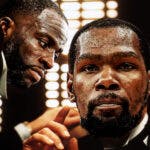The Golden State Warriors got off to a 1-0 start to their series against the Portland Trail Blazers, cruising to a 116-94 victory after a rousing 39-point fourth quarter and a game-high 36 points from Stephen Curry. The free style of play was much more visible than it was in a semifinal series against the Houston Rockets, but the defending champions still have some puzzles to solve before they can look ahead to the NBA Finals.
These are 5 Clutch Points from Game 1 of the Western Conference Finals:
Splash Brothers back to splashing
Stephen Curry and Klay Thompson picked up where they left off, shooting the roof off Oracle Arena and accounting for 12 of the 17 threes the Warriors made in Game 1.
Curry had his best all-around postseason game since the first one against the L.A. Clippers, scoring a game-high 36 points and shooting 12-of-23 from the field and 9-of-15 from deep — the most threes he's made in a game this postseason.
https://twitter.com/TheRenderNBA/status/1128488142607196161
The two-time MVP constantly found space to shoot comfortable, on-balance shots, which led to more adventurous antics down the road.
Steph Curry is feeling it 🔥 pic.twitter.com/QC08hdQJMS
— Dime (@DimeUPROXX) May 15, 2019
The clip above was his second 3-pointer in a span of 27 seconds, which opened up a nine-point lead at the half.
Thompson, who scored 26 in the game, was only 3-of-9 from deep, but found plenty of open looks in the game, despite failing to connect — a much different tale than what he saw against the Houston Rockets.
Blazers failing to trap and top-lock shooters
One of the main reasons why the Blazers went from trailing by six in the third quarter to losing by 22 in this game was their defense on shooters, especially one as deadly as Stephen Curry, who made 9-of-15 (60%) of his shots from beyond the arc.
Anthony Slater of The Athletic brought that to light during the post-game press conference, only to get “one of the most gangsta answers ever from a coach,” according to his colleague Marcus Thompson II.
Here is the exchange between the reporter and Blazers' coach Terry Stotts:
Slater: “Houston had some success trapping Steph and really getting out on him, is this sustainable for you guys to keep dropping?”
Stotts: “Did they — I can't remember, when he had 33 in the second half were they trapping him then?”
Slater: “Yeah.”
Stotts: “They were? And they scored 33 in the second half?”
Slater: “Yeah.”
Stotts: “Okay, we'll look at that.”
https://twitter.com/TheRenderNBA/status/1128521504860323842
While Stotts can put on the proverbial gangsta.gif glasses for this nonchalant response, he's all sorts of wrong and he likely knows it.
The Rockets limited Curry to a feeble 28% from deep, hitting only 19 of his 68 total attempts from distance — failing to shoot above 30% until his last game in the series, where he made 4-of-11 (36%) from deep.
Now any time a team deals with defending a diverse player, it becomes a pick-your-poison scenario, which is what Stotts was referring to with his response. The Rockets trapped high at the end of Game 6 and Curry picked them apart in the high pick-and-roll, allowing Draymond Green to get free and play four-on-three in several instances down the stretch.
The Blazers also don't have the same personnel than the team built specifically to take down the Warriors — no P.J. Tucker, no Eric Gordon, no Chris Paul, no beefed up James Harden who is now willing to play defense.
Yet some of these things are correctable, as it was Enes Kanter and backup Zach Collins giving Curry enough daylight to shoot as comfortably as if it was Green taking the shot instead.
☔️ @StephenCurry30 fuels the @warriors Game 1 home W with 36 PTS, 9 3PM, 7 AST, 6 REB! #StrengthInNumbers #NBAPlayoffs
Game 2: Thursday (5/16), 9pm/et, ESPN pic.twitter.com/9uZJXPUQqi
— NBA (@NBA) May 15, 2019
The clip above showcases plenty of scenarios in which Kanter or Collins are found sagging in the lane, giving Curry roughly 10 feet of space and failing to come out to challenge the shot.
It is a pick your poison scenario for this Blazers team, but they're picking lethal venom here, as trading for wide-open 3-pointers with a 43.6% career 3-point shooter is a sure way to go out of these Western Conference Finals.
Active hands, active bodies
Golden State limited Portland to 36% shooting for the game and that is by no means a coincidence.
The Warriors were actively flying at shooters, recovering to make key stops and getting out on the break through each of their 13 steals. The defending champions forced 21 turnovers and kept the trio of Damian Lillard, CJ McCollum and substitute extraordinaire Rodney Hood under 20 points each — a recipe that worked wonders against the fifth-best offense in the league.
The trio made most of its damage from the foul line, converting 18 of their 19 shots from the stripe, which is what largely kept them in the game.
Draymond Green had another fantastic effort, rounding out his mixed bag of goods with 12 points, 10 rebounds, five assists, two steals and three blocks in only 34 minutes of play.
The Warriors won the battle by playing at their own breakneck pace, outscoring the Blazers 17-2 in fast break points and grabbing a commanding 31-12 advantage in points off turnovers.
The Enes Kanter riddle
While Kanter had his share of woes at the defensive end, failing to close out on open shooters, he nearly made up for it with his impact on the offensive end.
Steve Kerr opted to double Kanter early in the game, but the Turkish big man picked the Warriors apart with his underrated passing, finding open cutters for easy baskets.
Adding to that dimension of his game was the constant threat of his presence on the glass, as he ensnared a whopping 16 rebounds, five of them offensive — which ultimately proved to keep the Blazers in the game for three quarters.
It didn't make much of a difference in Game 1, but Kanter's rebounding ability can pose a problem for the Warriors in close games, as his offensive boards can be as deflating as a late-game turnover in some situations.
Despite starting Andrew Bogut (played only eight minutes), Golden State went small for the vast majority of the game, pairing up Kevon Looney, Jordan Bell and Jonas Jerebko with Green.
It's likely the Warriors will need a bigger body like Bogut to bang with Kanter on the block and keep him off the glass in some situations, though it all depends on the adjustments Terry Stotts makes moving forward.
A Damian Jones sighting
Damian Jones, the 7-foot center that started the season as part of the Warriors starting five, made a small cameo in the waning minutes of regulation after missing the last five-and-a-half months with a torn pectoral muscle.
The Vanderbilt standout had yet to make an appearance since first suffering the injury during a Dec. 1 loss to the Detroit Pistons.
While most of the injury report alarm has been about the impending return of Kevin Durant and even DeMarcus Cousins, the Warriors could use another body for extra minutes and one that can absorb fouls while contributing on the glass.
Jones' all-around game is still unrefined, but he is a lob-catching presence and a sure-handed catcher of quick passes, which makes him a viable option at center.
If the Warriors get past the Blazers — and there isn't much suggesting they won't — Jones' presence and availability could prove helpful in the NBA Finals, when the Warriors take on centers like Brook Lopez of the Milwaukee Bucks or Marc Gasol of the Toronto Raptors.
If Cousins is unable to return by then, Jones makes for a good consolation addition and one that will only strengthen the depth of this team.




